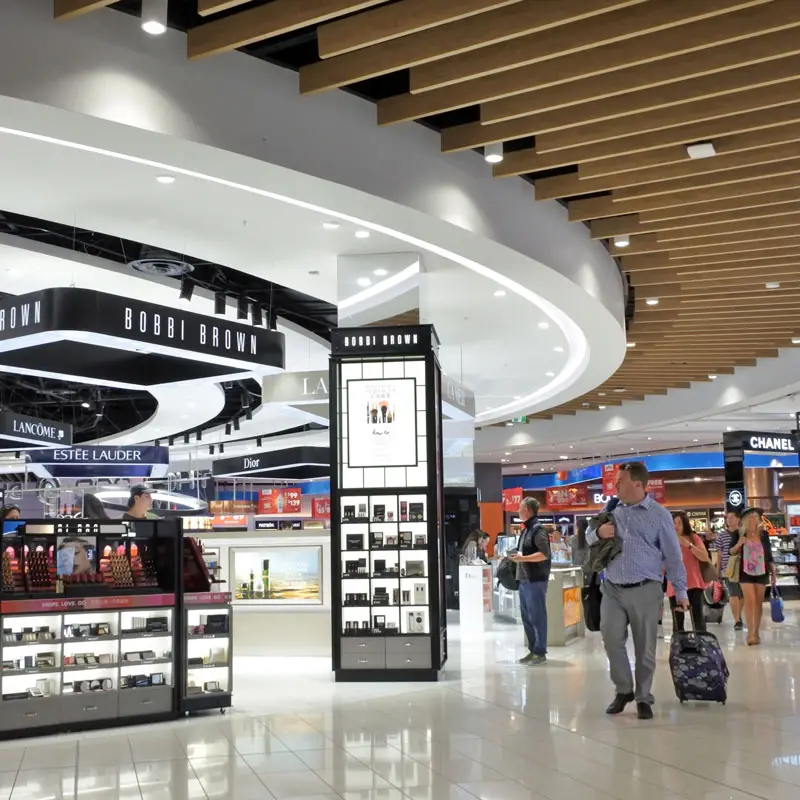The modern airport has become a version of cold war Berlin — a city divided. In the biz it’s called landside and airside, separated by the wall of security and our version of Check-Point Charlie. The Stasi-like TSA guards bark about laptops and shoes; the security checks are perfunctory and arbitrary, and the waits are interminable. The entire entry to a flight at an airport could not be more miserable.
By Design
The starting point for airport design is the aircraft the facility expects to service. It is more engineering than design. Knowledge and experience in runway lengths, the thickness of the tarmac, and the building configurations needed to accommodate specific airplanes models are paramount in the choice of the firm retained to design and build an airport. Retail, not to mention some empathy with the needs of travelers, are way down on the priority list.
For those of us traveling in North America the experience varies widely — according to the age of the airport. To my road warrior eye, the ancient JFK and O’Hare represent the lowest end of the spectrum (because expectations are so high). Denver, Pittsburgh and the Detroit airports are newer and better. The new LaGuardia is an improvement … but still. No American airport comes close to Dubai and Singapore, yet those facilities still have serious flaws. Everyone who travels anywhere in the world has horror stories.
Taking Ownership
The management of many major airports like Heathrow and Gatwick has been privatized. In North America, many airports are controlled by autonomous agencies (like the Port Authority which operates the New York Metro airports) whose answerability to the traveling public is tenuous. Retail for them is a way to either recoup costs and/or make a contribution to operating margins.
Given that airports are public facilities and feed off a strictly captive market, the balance between public service and private enterprise needs attention. The big issues are who is willing to pay the rent and who should be there in the first place. Duty-free and luxury brands are on one side of the equation and food service and other non-luxury retail on the other.
On the Radar
Years ago, we took a detailed look at two transportation hubs: Dublin Airport in Ireland and Euston Station in London. We tracked travelers from the moment they stepped off the curb from whatever transportation brought them to the airport or station to the moment they climbed onto the airplane or train. It required a 30-person research crew, and it was the most complex research job we had ever run. To most of us who travel extensively, it wasn’t just a job, it was also personal. We wanted to make a difference. And we’re still at it. Airport and duty-free work has continued from Charlotte, Boston and Tel Aviv, to Seoul, New Delhi and Sao Paulo.
Tracking Devices
Much of it was just stopwatch work. While in a post-Covid world, the numbers have gotten worse, the basic ratios remain the same: In the total travel experience, on average, one-third of everyone’s time it is spent landside (before the gate area), roughly thirty-plus minutes. That includes checking in and getting through security. On the airside (the gate area) we average more than an hour, and 69 percent of travelers shop, 65 percent purchase food and beverage items, and 43 forty percent use a restroom.
What surprised us is that we knew more about how travelers spend their time (and money) than airport operators. Whether at the Tax-Free World Conference or in meetings with airport planning and management agencies across the world, it was clear how little airport owners actually knew about the traveling experience. While many facilities and airlines run customer satisfaction surveys, they had little idea of who went where, for how long, and why.
Keeping Track of Time
One curious finding was the shared anxiety travelers have over time. Despite watches and phones, the worry about departure times and distance to the gate were paramount. Better electronic signage systems in-store and food service locations are one simple solution as well as including the required time to reach the gate. At the new Istanbul airport, it was a 1.5-mile walk from the international arrival gate to the domestic gate for my next flight. I needed to know that to plan for the trek.
Way Stations
With so many airlines cutting back on in-flight services the explosion of eating and drinking business at airports are completely understandable. The restrooms are understandable necessities as well. The toilets in the economy section of a full airplane are the filthiest places you can find in the public domain.
So, upgrading and improving airport restrooms is even more of a priority. Airport women’s restrooms need to be twice the size of the mens room. Women need more space because they carry more things. (By the way, we recommend the same change in theaters, malls, and any other public facilities.) One idea we had was to offer bathroom sponsorships. Imagine if Estee and P&G armed attendants with samples of moisturizers, cleansers and fragrance. A stressed-out female traveler woman is grateful for anything that makes the experience less painful.
Sightlines
One simple observation: Airport retail design does not recognize that thanks to rolling suitcases, the aisle configurations need to be planned as if everyone were pulling rather than pushing a baby stroller. In other words, wider aisles. And also recognize that many travelers have only one hand free, the other is carrying or pulling luggage so that navigation can be dicey.
Retail Windows of Opportunity
We endure the stress of the rush not to miss the flight, but also the stress of delays. So, retailers, leverage the delays in your favor. Make travelers feel better with instant gratification rewards. Chanel lipstick and fragrance are no-brainers.
Most travelers’ suitcases are stuffed. In that spirit, airport retailers can showcase products where fulfillment is online, delivered to your home or office. The only way you fall in love with that massage chair is to try it. Or home décor from the Museum Store. Or those boots you’ve been longing for that definitely won’t fit in your carry-on bag.
Duty-free is an interesting challenge. There are the travelers with the sophistication to know the differences among single malt scotches … but there are those who do not. The inclusion of educational signage is an easy way to start a conversation and get customers to trade up.
Cross-merchandising the store needs to reflect travelers’ states of mind. We liked the idea of a comfort section, where pillows, light blankets, and sleep masks were merchandised together.
Jewelry and handbags are about good mirrors and lighting … and subject for another article.
Bonus Card
At a recent conference on Placemaking, I heard a funny talk on how an ice cream cart can transform a public place. In the same spirit, we need to move past fixed seating and give people moveable chairs and desk space. In the airport in Qatar, you can rent a covered single bed to take a nap and have a wake-up service.
It’s time for us to get past the traditional Hudson News model. Airports represent a real opportunity. The global traveler deserves better. So does the domestic passenger.





